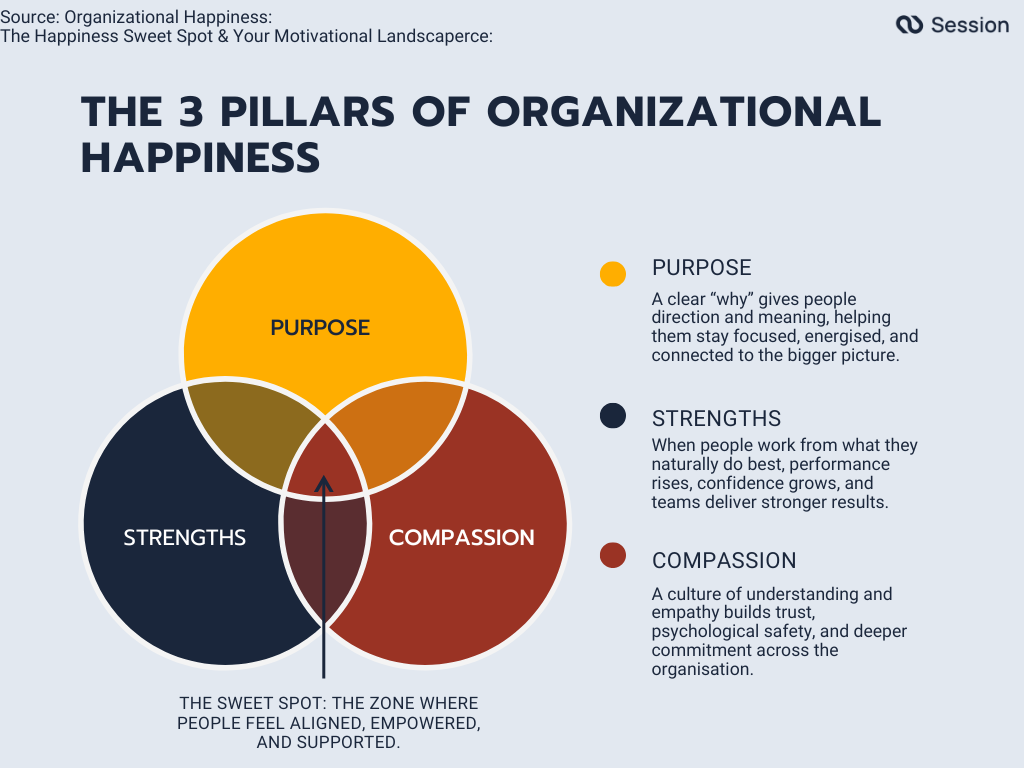People are paying more and more attention to the importance of happiness at work - and rightly so - given that the average person spends 90,000 hours at work in a lifetime. It’s important to figure out how to improve engagement levels and ensure that employees derive satisfaction and a sense of fulfilment from their jobs or careers. Happiness at work stems from being purpose-driven, honing in on strengths, and cultivating a culture of compassion. In this article, I will walk you through why ensuring happiness at work is of utmost importance, and examine strategies that facilitate a work culture of well-being, engagement and high performance. I call this Organizational Happiness.
What Exactly Is Happiness? How Can it Be Achieved at Work?
Before I delve into happiness at work, let’s first take a look at the definition of happiness:
"Happiness is the experience of frequent, mildly pleasant emotions, the relative absence of unpleasant feelings, and a general feeling of satisfaction with one's life" - Biswas-Diener & Dean, 2007
Because happiness tends to be such a broadly defined term, psychologists generally use the term 'subjective well-being' when they talk about this emotional state. Subjective well-being tends to focus on an individual's overall personal feelings about their life, and include the following two components:
- The balance of emotions: Although we all experience both positive and negative emotions, happiness is generally linked to experiencing more positive feelings than negative.
- Life satisfaction: This relates to how satisfied you feel with areas of your life including your relationships, work, achievements, and factors that are important to you.
Next, let’s look at happiness within the organizational context. There is consensus that organizational happiness positively affects organizational climate and improves the productive performance of human capital. When applying happiness to the work setting, research suggests that happiness at work can be associated with greater professional success, higher income, better job performance and a tendency to help others in their jobs. It also may lead to efficiency and the achievement of organizational goals, which is the ultimate benefit that an organization could receive. Organizational happiness is so important, that it has even been recognized in the United Nations Sustainable Development Goals as SDG Number 3 - good health and well-being. In particular, SDG No. 3 aims to ensure good health and well-being, which translates into guaranteeing the promotion of a healthy lifestyle and well-being for people of all ages, with a multidisciplinary approach. From an organizational perspective, this objective refers to the study of the factors and processes that may make people happy or unhappy at work. Evidently, the work cultures and environments in which people work are hugely influential on their well-being. It is difficult to remain mentally healthy in an unhealthy environment, so fixing the setting first - rather than the individual - is a critical first step in promoting organizational happiness.
Organizational Happiness is an opportunity and an obligation to take a social responsibility. Not just talking about it.
The practical question remains, how can organizations effectively implement strategies to promote and foster a culture of organizational happiness? Let’s take a look at The Organizational Happiness Sweet Spot which consists of three pillars: purpose, strength, and compassion. I wrote Organizational Happiness with an aim in mind of creating a real and unique competitive advantage for organizations - and to go beyond traditional strategic and management consulting “quick fixes” by creating sustainable results built on a fundamental focus of Purpose, Strengths and Compassion.
Let’s break these down and look at each individual component:

Purpose
The first pillar of organizational happiness is purpose, which is your organizational why. It’s a heartfelt “reason for being” that is bigger than profit. When market conditions are right, companies can be successful with a pure profit purpose. But a lot of potential is released when it’s more than that. When your purpose is clear, many other things get easier: your storytelling to customers about why to buy, attracting the best people to your organization, and more. When it is really good, your organizational why resonates—does not conflict—with the personal why of the people in the organization.
- Purpose brings meaning.
- Having a strong heartfelt purpose is a competitive advantage.
- Your purpose is your employer brand.
And you need a strong purpose to attract and retain top talent. If you don’t have that, your organization will struggle and not last.
Strengths
The second pillar of organizational happiness is strengths-based leadership and real talent management. That means discovering people’s talents, strengths, and potential and putting them into play for your organization. Focusing on strengths and what’s working well will result in the highest employee engagement.
- Conversations about strengths reveal the superpowers in an organization.
- Effective talent management recognizes that everybody has talent, potential, and strengths.
- Strengths-based leadership unlocks an organization’s potential.
- A successful talent management strategy requires simple processes and enabling tools.
It should come as no surprise that ignorance results in the lowest engagement. A focus on problems and what’s not working, with a fix-it attitude, leads to higher engagement. But it’s not nearly as high as the engagement that is stimulated by a strengths-based approach.The sense of achievement and accomplishment that strengths incite are essential for promoting well-being and happiness.
Compassion
The third pillar of organizational happiness is cultivating a culture of compassion. It means people are interested in understanding the difficulties of other people and have, and maintain a burning desire to help them.
- Compassion and curiosity increase employee loyalty and trust.
- Compassion boosts team performance by helping employees feel “psychological safe”
- Compassion facilitates the spirit of experimentation and is critical for creativity.
The way I see it, compassion is about leadership and leadership is about compassion. If you aspire to be an effective leader, you can’t do it successfully without compassion. Research has demonstrated that even before establishing their own credibility or competence, leaders who project warmth are more effective than those who lead with toughness. Compassion, kindness, and warmth accelerate trust, which is a building block for performance and teamwork. Real leadership is “Compassion In Action”.
Happiness at Work: Why Does it Matter?
Happiness at work is unfortunately not a guarantee - although it should be aimed for and nurtured by organizations. Research by Gallup shows that happy employees are engaged employees. An engaged employee is someone who works with passion and feels a profound sense of connection to their company. Engaged employees are typically innovation drivers that possess the momentum and desire to move the organization forward. On the opposite end, disengaged employees have more than likely ‘checked out’ of their work life - they put time, rather than passion into their work - with time equating to a paycheck and not much else.
In a New York Times Survey of 12,000 employees, 50% said they didn’t get a feeling of meaning and significance from their work, but those who did reported 1.7 times greater job satisfaction, were 1.4 times more engaged, and were more than three times as likely to remain with their current employer. Evidence from psychology, leadership and management studies, and even neuroscience supports the view that not only is it possible to find happiness at work, but that doing so is linked to higher engagement levels and overall higher levels of satisfaction. Happier employees enjoy an array of positive outcomes; from day-to-day health to productivity to career advancement, and this has been proven to continually improve the bottom line for the organization as a whole. And we haven’t even scratched the surface yet! Happiness at work has been tied to just about every desirable outcome that individuals, workplaces, and organizations could wish for.
Let’s take a look at some examples: Being happier at work is tied to better health and well-being, more creative and effective problem solving, more productivity and innovation, and faster career advancement. People who are happier at work are also more authentic, more committed and driven to work. Studies conducted by Gallup report that happier workplaces report less turnover, lower health care costs, fewer mistakes and accidents, more efficiency, greater shareholder value, and quicker rebounds in the wake of adverse events or failures; they also earn higher customer loyalty, commitment, and business growth via word-of-mouth endorsement. I could go and on about the importance of cultivating happiness, meaning, and purpose at work - but I’m sure by now you get the picture.
“You have a sense of purpose when you make valuable contributions to others (individuals and organizations) or to society that you find personally meaningful and that don’t harm anyone.” - UC Berkeley management professor Morten Hansen.
The Importance of Psychological Safety in the Workplace
Creating a work culture of engagement and happiness cannot take place without psychological safety in the workplace. Psychological safety can be defined as:
‘’A belief that one will not be punished or humiliated for speaking up with ideas, questions, concerns or mistakes." - Amy Edmondson, Harvard Business School Professor
Amy Edomonson’s research on what makes a psychologically safe team revealed a surprising insight: better teams make more mistakes, not fewer. In Edmonson’s words, psychological safety means letting up on the breaks. For example, if leaders only talk about accountability and a culture of performance excellence, they risk employees slipping into the ‘’anxiety zone’’ - in which they are too afraid to voice their opinions or raise their concerns. One of the keys of psychological safety is that people feel comfortable voicing their opinions and do not fear being judged. To ensure that teams and individuals are able to voice their inputs and opinions in a safe environment, create some guidelines on how they interact with one another. Examples include:
- Active listening without interruption
- Accepting varied ideas as valid, accepted, and never judged
- Not placing blame on a person for voicing their opinion
- Encouraging and listening to out of the box suggestions, and recognizing that everyone is different
Psychological safety is more important today than ever before, as the pandemic has left employees feeling anxious and more uncertain of their futures than ever before. What’s more, remote and hybrid work requires a deeper practice of psychological safety:
“Distributed work'' is making us realize we have to be more deliberately—more proactively—open. We have to be explicit in sharing our ideas, questions, and concerns, because we can't just overhear what's happening in the next cubicle. We now have to work a little harder to share what we're thinking, to ask questions.
With the importance and necessity of psychological safety in mind, ensure that you are creating a safe and trusted environment in which people can voice their concerns, share opinions, and talk openly without fear of repercussions. Psychological safety truly is the cornerstone of happy and productive workplaces.
What Does A Purpose-Driven, Engaged, and Happy Organization Look Like?
A purpose-driven company stands for and takes action on something bigger than its products and services. Purpose can be an organizational strategy and a roadmap to remain competitive in a rapidly-changing world. According to PwC, 79 percent of business leaders believe that purpose is central to success. However, according to Gallup, less than half of employees know what their organization stands for and its central mission is. It goes without saying that organizations that don’t prioritize and make their purposes clear will suffer: not just from a PR standpoint, but also internally - as employees are likely to feel more disengaged if they do not know what they are working towards.
We can look at companies such as Patagonia as examples of purpose-led organizations. Patagonia instills core values of conservation and family into their workplace culture by sourcing environmentally sound materials for their products, discouraging excessive purchases in their marketing campaigns, and providing on-site child care and flexible return-to-work schedules for new parents.
Another example of a company that has put their purpose statement into action is Alaska Airlines, which focuses on a sense of stewardship for the people and places it serves. To bring that ethos to life, Alaska Airlines sets measurable targets around three key pillars: “make flying matter,” “invest for stronger communities,” and “fly greener.” To fly greener, the company is tackling the air pollution caused by commercial aircraft. In 2013, it became one of the first airlines to outfit a portion of its fleet with split scimitar winglets. This improved the efficiency of each plane by about 34,000 gallons of fuel annually, saving a total $20 million in annual fuel costs. Furthermore, the company has stopped serving non-recyclable plastic straws and citrus picks, continuing their commitment to sustainability.
It comes as no surprise that companies such as Patagonia and Alaska airlines - committed to clear and actionable purpose-driven goals - benefit in having engaged employees. Combining purpose with strength and compassion, is a sure way to improve happiness and engagement in the workplace.
When The Pursuit of Happiness at Work Backfires
It’s important to make the distinction that happiness is, and should be - of fundamental importance to organizations. However, when the concept of happiness is pushed, without considering the essential pillars of compassion, strength, and purpose - it can actually have negative effects. For example, when happiness becomes a duty, it can make people feel worse if they fail to accomplish it. This is particularly problematic in the present era, where happiness can often be ''preached’’ as a moral obligation. In our modern society, we can see happiness incentives permeate a number of corporations. For example, Google, among many others, has a Chief Happiness Officer (CHO). Since 2010, with the publication of Delivering Happiness, the job of CHO has been featured prominently in large corporations. The CHO is responsible for a range of staff happiness initiatives that can include company perks, such as free lunches, nap pods, and free gym memberships, as well as monitoring day-to-day company culture.
Sure, it’s great to treat employees to some nice company perks, but it’s also important to note that cultivating workplace happiness isn’t just done at the superficial, external level. Nap pods and funky office spaces are fun, but developing a core sense of happiness and engagement - using the three pillars, compassion, strength, and purpose - and making this an integral component of your organization’s mission, is where the real magic happens. Perks that a CHO brings can be great (and fun) add-ons, but it is important to remember that aspects such as psychological safety, fair wages, good work-life balance, and flexibility far outweigh nap pods, fancy coffee machines, and unlimited snacks.
Organizational Happiness is not an “employee service”, it should be a top strategic priority at board and c-suite level. Because your business depends on it and it’s a win-win-win. For the individual, for society and for the organization.
Conclusion
It is clear that well-being promotes performance. Leading a team in a psychologically safe environment, and demonstrating strengths-based leadership, purpose and cultivating a culture of compassion is not an easy feat - but it is essential - for individuals, teams, and organizations to thrive and perform to the best of their abilities. Take the time to foster wellbeing in the workplace and see your employees - and your business - flourish.












